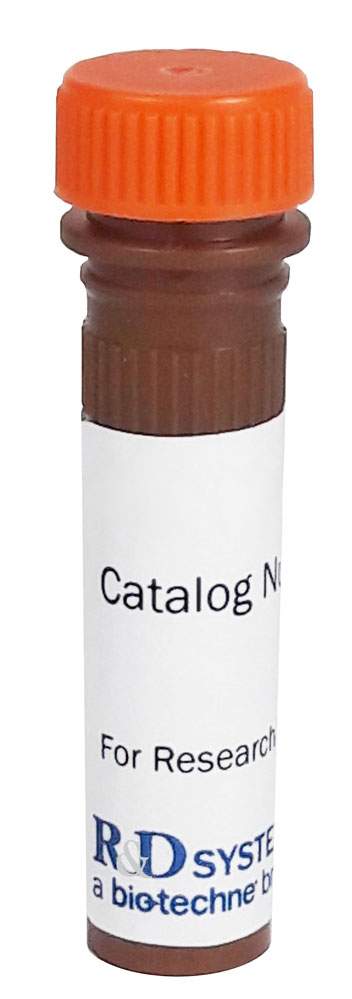Mouse HVEM/TNFRSF14 Alexa Fluor® 700-conjugated Antibody
Mouse HVEM/TNFRSF14 Alexa Fluor® 700-conjugated Antibody Summary
Gln39-Val207
Accession # NP_849262
Applications
Please Note: Optimal dilutions should be determined by each laboratory for each application. General Protocols are available in the Technical Information section on our website.
Reconstitution Calculator
Preparation and Storage
Background: HVEM/TNFRSF14
HVEM (herpesvirus entry mediator) is a type I membrane protein that is TNF receptor superfamily member 14 (TNFRSF14) (1). The mouse HVEM cDNA encodes a 275 amino acid (aa) protein. It contains a 36 aa signal peptide, a 170 aa extracellular domain with three cysteine rich domains (CRD), a 24 aa transmembrane region and a 45 aa cytoplasmic tail with a TRAF interaction domain (1). HVEM expression is highest on naïve, memory and regulatory T cells, but declines during T cell activation (2, 3). It is present at low levels on most resting leukocytes (4). HVEM is a receptor for the IGSF member BTLA (B and T lymphocyte attenuator), CD160, and the TNF family ligand LIGHT (lymphotoxins, exhibits inducible expression, and competes with HSV glycoprotein D for HVEM, a receptor expressed by T lymphocytes) (2, 9). HVEM and BTLA are constitutively expressed on T cells, while LIGHT is generally considered to be inducible upon TCR activation. In the absence of activation, HVEM and BTLA interact monomerically, either in cis, or in trans. A same cell (or cis) interaction likely promotes general cell survival, while a between cell (or trans) interaction promotes a state of lymphocyte inactivity through the BTLA cytoplasmic domain. Following T cell activation, LIGHT appears and disrupts existing HVEM-BTLA bonds. A LIGHT-HVEM trimer now forms in trans, initiating HVEM-mediated NF kappa B signaling and a proinflammatory response (10). BTLA and LIGHT interactions are not mutually exclusive, but BTLA appears dominant (4, 6, 7). The herpesvirus envelope glycoprotein gD, which binds HVEM CRD1 to initiate membrane fusion, can antagonize both BTLA and LIGHT binding (1, 6, 7, 9). Human, but not mouse, HVEM can also bind lymphotoxin a within CRD2 3 (9, 11). Graft‑vs‑host disease and Th1 type intestinal inflammation can be ameliorated by interrupting T cell LIGHT/HVEM interactions, while disruption of BTLA/HVEM interaction promotes intestinal inflammation (12-14). Mouse HVEM ECD shares 89% and 53% aa identity with rat and human HVEM, respectively. Mouse HVEM can recognize human BTLA and LIGHT, but human HVEM does not recognize mouse ligands (2, 11).
- Hsu, H. et al. (1997) J. Biol. Chem. 272:13471.
- Sedy, J.R. et al. (2005) Nat. Immunol. 6:90.
- Tao, R. et al. (2008) J. Immunol. 180:6649.
- Wang, Y. et al. (2005) J. Clin. Invest. 115:711.
- Nelson, C.A. et al. (2008) J. Immunol. 180:940.
- Gonzales, L.C. et al. (2005) Proc. Natl. Acad Sci. USA 102:1116.
- Compaan, D.M. et al. (2005) J. Biol. Chem. 280:39553.
- Cai, G. et al. (2008) Nat. Immunol. 9:176.
- Mauri, D.N. et al. (1998) Immunity 8:21.
- Ware, C.F. (2008) Immunol. Rev. 223:186.
- Bossen, C. et al. (2006) J. Biol. Chem. 281:13964.
- Xu, Y. et al. (2007) Blood 109:4097.
- Wang, J. et al. (2005) J. Immunol. 174:8173.
- Steinberg, M.W. et al. (2008) J. Exp. Med. 205:1463.
Product Datasheets
Product Specific Notices
This product is provided under an agreement between Life Technologies Corporation and R&D Systems, Inc, and the manufacture, use, sale or import of this product is subject to one or more US patents and corresponding non-US equivalents, owned by Life Technologies Corporation and its affiliates. The purchase of this product conveys to the buyer the non-transferable right to use the purchased amount of the product and components of the product only in research conducted by the buyer (whether the buyer is an academic or for-profit entity). The sale of this product is expressly conditioned on the buyer not using the product or its components (1) in manufacturing; (2) to provide a service, information, or data to an unaffiliated third party for payment; (3) for therapeutic, diagnostic or prophylactic purposes; (4) to resell, sell, or otherwise transfer this product or its components to any third party, or for any other commercial purpose. Life Technologies Corporation will not assert a claim against the buyer of the infringement of the above patents based on the manufacture, use or sale of a commercial product developed in research by the buyer in which this product or its components was employed, provided that neither this product nor any of its components was used in the manufacture of such product. For information on purchasing a license to this product for purposes other than research, contact Life Technologies Corporation, Cell Analysis Business Unit, Business Development, 29851 Willow Creek Road, Eugene, OR 97402, Tel: (541) 465-8300. Fax: (541) 335-0354.
FAQs
No product specific FAQs exist for this product, however you may
View all Antibody FAQsReviews for Mouse HVEM/TNFRSF14 Alexa Fluor® 700-conjugated Antibody
There are currently no reviews for this product. Be the first to review Mouse HVEM/TNFRSF14 Alexa Fluor® 700-conjugated Antibody and earn rewards!
Have you used Mouse HVEM/TNFRSF14 Alexa Fluor® 700-conjugated Antibody?
Submit a review and receive an Amazon gift card.
$25/€18/£15/$25CAN/¥75 Yuan/¥1250 Yen for a review with an image
$10/€7/£6/$10 CAD/¥70 Yuan/¥1110 Yen for a review without an image



